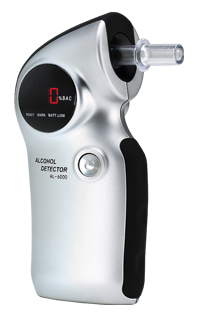Electrochemical determination of ethanol in exhaled air

|
| Illustration photo from Alkohol-tester.cz. Breathalyzer [online]. [feeling. 2010-02-09]. < http://alkohol-tester.cz/ > foto z |
Until recently, the most widely used method for detecting alcohol in breath was based on the oxidation of ethanol to acetic acid against dichromate. Hexavalent chromium, whose compounds are orange, was reduced to Cr3+ , whose salts are blue-green. The disadvantage of this method was the use of dangerous compounds (CrVI+ is carcinogenic) and the low specificity of the determination.
Nowadays, electrochemical alcohol detectors are much more widely used . In this case too, the reducing properties of ethanol are used, which can be easily oxidized (dehydrogenated) to acetaldehyde or acetic acid:
- CH3CH2OH → CH3CH=O + 2 H+ + 2 e−
as the case may be
- CH3CH2OH + 1/2 O2 → CH3COOH + 2 H+ + 2 e−
The reaction can take place on a suitable positively charged electrode (see below), which removes electrons from ethanol. The protons then travel to the negatively charged electrode, where they accept the same number of electrons and combine with oxygen to form water:
- 2 H+ + 1/2 O2 + 2 e− → H2O
The concentration of ethanol will then correspond to the intensity of the current that flows between the anode and the cathode.
Cheaper alcohol breath detectors usually use a semiconductor sensor to oxidize ethanol , most often made of tin oxide SnO2 doped with e.g. rare earth metals. In this case, the rate of ethanol oxidation strongly depends on the temperature, so the sensor is tempered. Semiconductor detectors are not completely selective, similarly to ethanol they also react to other substances that can be similarly oxidized (e.g. menthol and other essential oils, aldehydes, etc.). This can cause false positive alcohol breath test results, e.g. after consuming fruit juices or certain sweets. If there is concern about such false positive test results, the measurement is repeated after 15 minutes. In general, however, it can be said that the sensitivity and specificity of semiconductor alcohol detectors greatly depend on the exact composition and surface treatment of the sensor.
More accurate devices use a so-called (fuel cell). Its body consists of an inert porous material filled with an electrolyte (sulfuric acid). It is surrounded on both sides by platinum electrodes with an active surface (platinum black). Although this type of sensor is more expensive, its sensitivity does not depend so much on temperature and tends to be significantly more selective for ethanol.
Breathalyzers have undergone extensive development. Modern devices can be calibrated very precisely, their sensors have excellent stability over time, etc. They also control the volume of the sample taken for determination, so that the measurement takes place in the air exhaled from the lung alveoli (and not, for example, from the upper respiratory tract) and the results thus correspond to the concentration of alcohol in blood.
links[edit | edit source]
References[edit | edit source]
- Intoximeters Inc. Fuel Cell Technology [online]. [cit. 2010-02-09]. <http://www.intox.com/t-FuelCell.aspx>.
- Intoximeters Inc. Fuel Cell Technology Applied to Alcohol Breath Testing [online]. [cit. 2010-02-09]. <http://www.intox.com/t-FuelCellWhitePaper.aspx>.
- RAO, B. Bhooloka. Zinc oxide ceramic semi-conductor gas sensor for ethanol vapour. Materials Chemistry and Physics. 2000, vol. 64, s. 62-65, ISSN 0254-0584.
- CHEN, Y, KY CHEN, and ACC TSEUNG. An electrochemical alcohol sensor based on a co-electrodeposited Pt|WO 3 electrode. Journal of Electroanalytical Chemistry [online] . 1999, vol. 471, no. 2, pp. 151-155, also available from < http://www.sciencedirect.com/science/article/pii/S0022072899002715 >. ISSN 0022-0728.
- PANDYA, HJ. Thin-film tin oxide ethanol sensor. International Journal of Signal and Imaging Systems Engineering. 2009, vol. 2, no. 1-2, pp. 3-6, ISSN 1748-0698.
- HUANG, Jin and WAN. Gas Sensors Based on Semiconducting Metal Oxide One-Dimensional Nanostructures. Sensors [online] . 2009, vol. 9, no. 12, s. 9903-9924, dostupné také z < https://res.mdpi.com/def50200eb4ead6daa94ad3b183918e111c6cfcee6be309cb4e1363892228b0ff36babcdda0b56080da21f35a5c0b22dfb5d2656f28c65be4e339d854b13d0c9ee656fb2517bb3b3de7cd731aa6316d940aa76d168b8cc58b08e5ac9d92b57548ed971575af32bbf930a01c85cd86cba21bd6d9cb0b5c40ebe18013dba18e47cbbd6073f5558621722defcdbdc593842?filename=&attachment=1 >. ISSN 1424-8220.
